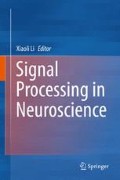Abstract
Electroencephalogram (EEG) recordings contain a large amount of information about physiological and pathological processes in the brain and serve as one of the important tools in clinical diagnosis and research regarding epilepsy. Dynamical similarity analysis is applied to characterize EEG changes in different absence seizure states. The average similarity measure of a pair of EEG signals in the same seizure states and across different seizure states is calculated using an improved dynamical similarity method. The results show that the average similarity measures between EEG segments within the seizure-free state are close to 1, suggesting that the EEG segments within the seizure-free state share the same dynamic characteristics. The similarity measures between EEG segments across different seizure states are typically smaller, indicating that the changes of dynamic characteristics can be found during different absence seizure states.
Access this chapter
Tax calculation will be finalised at checkout
Purchases are for personal use only
References
Buzsaki G. Rhythms of the brain. Oxford: Oxford University Press; 2006.
Cao L. Practical method for determining the minimum embedding dimension of a scalar time series. Phys D. 1997;110:43–50.
Danober L, Deransart C, Depaulis A, et al. Pathophysiological mechanisms of genetic absence epilepsy in the rat. Prog Neurobiol. 1998;55:27–57.
Ding M, Grebogi C, Ott E, Sauer T, Yorke J. Estimating correlation dimension from a chaotic time series: when does plateau onset occur? Phys D. 1993;69:404–24.
Eckmann J, Ruelle D. Fundamental limitation for estimating dimension and Lyapunov exponents in dynamical systems. Phys D. 1992;56:185–7.
Ferri R, Chiaramonti R, Elia M, Musumeci S, Ragazzoni A, Stam C. Nonlinear EEG analysis during sleep in premature and full-term infants. Clin Neurophysiol. 2003;114:1176–80.
Fraser AM, Swinney HL. Independent coordinates for strange attractors from mutual information. Phys Rev A. 1986;33:1134–40.
Grassberger P, Procaccia I. Characterization of strange attractors. Phys Rev Lett. 1983;50:346–9.
Grassberger P, Schreiber T, Schaffrath C. Nonlinear time sequence analysis. Int J Bifurcation Chaos. 1991;1:521–47.
Gribkov D, Gribkova V. Learning dynamics from non-stationary time series: analysis of electroencephalograms. Phys Rev E. 2000;61:6538–45.
Jansen B, Rit V. Electroencephalogram and visual evoked potential generation in mathematical model of coupled cortical columns. Biol Cybern. 1995;73:357–66.
Kim HS, Eykholt R, Salas JD. Nonlinear dynamics, delay times, and embedding windows. Phys D. 1999;127:48–60.
Lehnertz K, Elger C. Can epileptic seizures be predicted? Evidence from nonlinear time series analysis of brain electrical activity. Phys Rev Lett. 1998;80:5019–22.
Le Van Quyen M, Martinerie J, Baulac M, Varela F. Anticipating epileptic seizures in real time by a non-linear analysis of similarity between EEG recordings. NeuroReport. 1999;10:2149–55.
Li X, Ouyang G, Yao X. Dynamical characteristics of pre-epileptic seizures in rats with recurrence quantification analysis. Phys Lett A. 2004;333:164–71.
Lopes da Silva FH, Hoek A, Smith H, Zetterberg LH. Model of brain rhythmic activity. Kybernetik. 1974;15:27–37.
Navarro V, Martinerie J, Le Van Quyen M, Clemenceau S, Baulac M, Adam C, Varela F. Seizures anticipation in human neocortical partial epilepsy. Brain. 2002;125:640–55.
Packard N, Crutchfield J, Farmer J, Shaw R. Geometry from a time series. Phys Rev Lett. 1980;45(9):712–6.
Rabinovich M, Varona P, Selverston A, Abarbanel H. Dynamical principles in neuroscience. Rev Mod Phys. 2006;78:1213–65.
Rapp P, Zimmerman I, Alano A, Deguzman G, Greenbaum N. Experimental studies of chaotic neural behaviour cellular activity and electroencephalographic signal. In: Othmer H, editor. Nonlinear oscillations in biology and chemistry, Lecture notes in biomathematics. Berlin: Springer; 1985. p. 175–205.
Rogowski Z, Gath I, Bental E. On the prediction of epileptic seizures. Biol Cybern. 1981;42:9–15.
Sarkara M, Leong T. Characterization of medical time series using fuzzy similarity-based fractal dimensions. Artif Intell Med. 2003;27:201–22.
Schreiber T, Schmitz A. Classification of time series data with nonlinear similarity measures. Phys Rev Lett. 1997;78:1475–8.
Stacey W, Litt B. Technology insight: neuroengineering and epilepsy-designing devices for seizure control. Nat Clin Pract Neurol. 2008;4:190–201.
Stam C. Nonlinear dynamical analysis of EEG and MEG: review of an emerging field. Clin Neurophysiol. 2005;116(10):2266–301.
Takens F. In: Rand DA, Young LS, editors. Dynamical systems and turbulence, Lecture notes in mathematics. Berlin: Springer; 1981. p. 336.
Thiel M, Romano M, Kurths J. Influence of observational noise on the recurrence quantification analysis. Phys D. 2002;171:138–52.
Wendling F, Bellanger JJ, Bartolomei F, Chauvel P. Relevance of nonlinear lumped-parameter models in the analysis of depth-EEG epileptic signals. Biol Cybern. 2000;83:367–78.
Widman G, Schreiber T, Rehberg B, Hoeft A, Elger C. Quantification of depth of anesthesia by nonlinear time series analysis of brain electrical activity. Phys Rev E. 2000;62:4898–903.
Wolf A, Swift JB, Swinney HL, et al. Determining Lyapunov exponents from a time series. Phys D. 1985;16:285–317.
Author information
Authors and Affiliations
Corresponding author
Editor information
Editors and Affiliations
Rights and permissions
Copyright information
© 2016 Springer Science+Business Media Singapore
About this chapter
Cite this chapter
Ouyang, G., Li, X. (2016). Dynamical Similarity Analysis of EEG Recordings. In: Li, X. (eds) Signal Processing in Neuroscience. Springer, Singapore. https://doi.org/10.1007/978-981-10-1822-0_7
Download citation
DOI: https://doi.org/10.1007/978-981-10-1822-0_7
Published:
Publisher Name: Springer, Singapore
Print ISBN: 978-981-10-1821-3
Online ISBN: 978-981-10-1822-0
eBook Packages: Biomedical and Life SciencesBiomedical and Life Sciences (R0)

